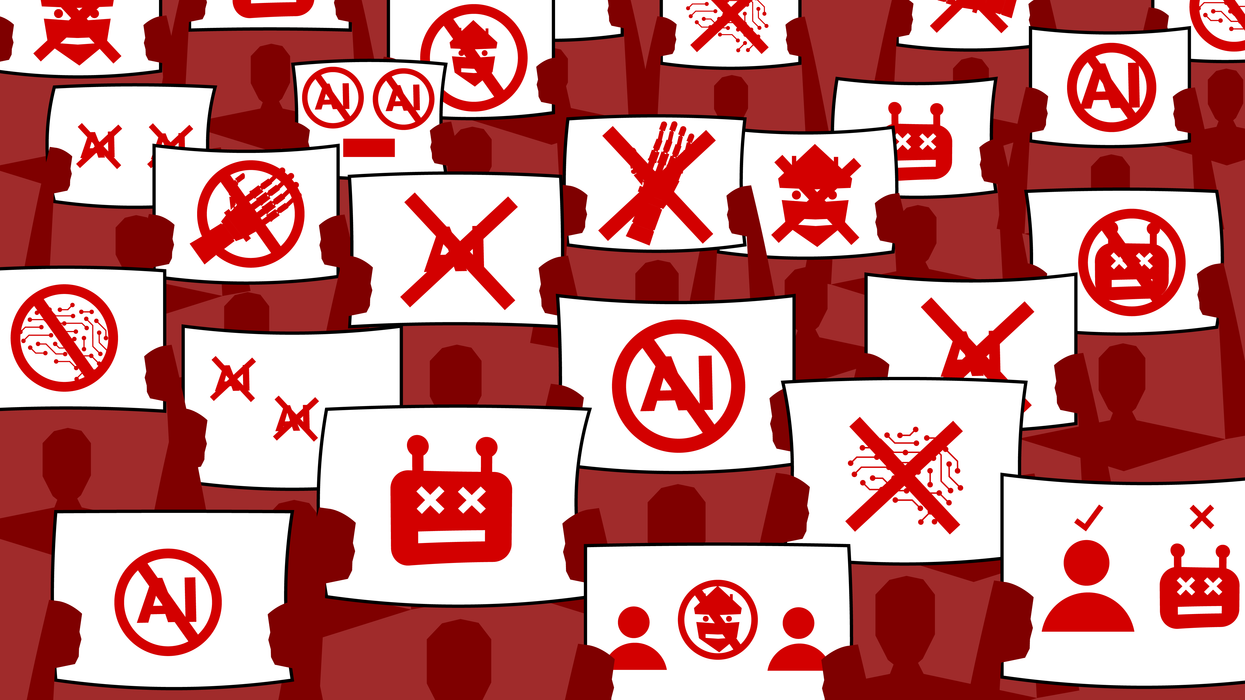Hollywood's Screenwriters Go to War With the Robots

This is the web version of dot.LA’s daily newsletter. Sign up to get the latest news on Southern California’s tech, startup and venture capital scene.
On this week’s “Succession,” Roman Roy flew to Burbank and met with the head of Waystar Studios, pressing them to greenlight more IP-driven films from major franchises. In the show’s fictional alternate reality, Roy is reacting specifically to the looming failure of sleepy robot-themed sci-fi tentpole “Kalispitron,” and the desperate short-term need to artificially boost the company’s stock price. Still, the scene itself has strong roots in our current business landscape. With media, telecom, and tech companies having recently spent billions creating and selling consumers on shiny new streaming platforms, they now need to actually deliver the quality content they’ve spent the last few years promising and promoting.
Sadly, negotiations between the Writers Guild of America (WGA) and the Alliance of Motion Picture and Television Producers (AMPTA) – representatives for Hollywood studios and the conglomerates that own them – ended without an agreement on Monday night. This has led to a writers’ strike threatening to shut down large sectors of the entertainment industry, with picket lines currently active across Los Angeles and New York.
Points of Disagreement
Some of the points of contention between the writers and the studios and networks hiring them go back several years now, if not decades, including debates about the minimum staff you can hire for a writers room and residual rates based on viewership.
Beyond these ongoing debates, which have largely been part of talks between writers and the industry since the last WGA strike in 2007, AI chatbots have also become a major point of this round of WGA-AMPTP negotiations. The WGA proposed new regulations around the use of AI, including guarantees from studio owners that it won’t be used to write or rewrite source material or literary material.
This means no asking chatbots for movie pitches which are then handed off to human writers for a polish, and no asking a chatbot to do its own pass on a script. The AMPTP rejected this proposal; their counter-offer was annual meetings between creative executives and writers to discuss the use of the technology. This was received particularly negatively by WGA members; on Twitter, “Into the Spider-Verse” and “21 Jump Street” vet Phil Lord called the AMPTP counterproposal “unserious.”
Speaking to The New York Times last month, screenwriter and Writers Guild negotiating committee member John August summarized the WGA’s concerns as “The Nora Eprhon Problem.” (It’s named for the late, legendary journalist-turned-screenwriter, who wrote “When Harry Met Sally,” “Heartburn,” “Sleepless in Seattle” and many other classics.) If it’s some day possible to feed all of Ephron’s work into a computer and get a new script that sounds like she wrote it… how do we fairly compensate the original writer? And would that meant the end of screenwriting as a profession?
The Writers Most Affected By AI Chatbots
It’s perhaps unsurprising that Hollywood writers are among the first organized labor groups pushing back against AI tools. The entertainment industry is famous for its attempts to sideline writers and squeeze them for every drop of their earnings. In 1996, John Gregory Dunne famously wrote “beating up on screenwriters is a Hollywood blood sport” while legendary producer Irving Thalberg memorably said “the most important person in the motion picture process is the writer… and we must do everything in our power to prevent them from ever realizing it.”
But this isn’t just about the threat of using a computer to write the next “Tár” or hailing ChatGPT as the new Tyler Perry. It’s unlikely the top creators with large fanbases will be replaced by famous computers, at least in the short-term. These changes will likely impact the lower levels of the industry first, with executives seeking out the kinds of content that can be downgraded in quality by 5-10% without audiences noticing or minding too much. Over time, more and more of entertainment becomes dull and homogenized, perhaps wtihout most of the audience even consciously noticing the change.
However the AI debate shakes out for the WGA, this process will very likely have far-reaching effects. Actors union SAG-AFTRA is considering similar rules around the right to use AI tools trained on an actor’s work to generate original performances, especially voice-only performances. As more and more employees in various industries suddenly find themselves competing with chatbots for jobs, the precedent set by the WGA-AMPTP negotiation could reverberate over the next several years or decades.
Max Merger and AI Incompetence Favor Writers
Fortunately for writers, they do seem to have picked a fertile moment for negotiations, now that their employers are facing the Waystar Studios issue. In just a few weeks, HBO Max and Discovery+ will merge into a brand new extremely high-profile streaming platform, dubbed simply “Max.” By the management team’s own admission, Max sits at the very center of WBD’s overall post-cable strategy. Back in March, WBD CFO Gunnar Wiedenfels called the new service “an absolutely critical milestone” and “one of our big, big priorities for this year.”
And while ChatGPT is certainly impressive technology… it’s not quite ready to write the “Succession” finale or a new season of “Hacks” just yet. AI can take tests, and can hold up its end of the conversation, and can even sometimes make you feel like you’re speaking to a real person. But it’s not particularly funny or skilled at storytelling, and simply by virtue of not having any sensory or life experiences, it doesn’t have much of a personality. It can write a sentence but can it write an insightful sentence? Can it have an insight? These are still theoretical questions.
Despite relying on studios for jobs, this gives writers a certain degree of natural leverage. In April, Netflix co-CEO Ted Sarandos assured investors that the company still had a “robust slate” of content stored up to release in the event of a writers strike. But even a vault full of “Indian Matchmaking” spinoffs isn’t going to last forever. Some form of agreement will need to be reached before subscribers begin bailing on the streamers that run out of content or start churning out lower-quality shows.
Though nothing is for certain, most early indicators make it seem like the strike could last for a while. With the WGA publicly releasing its list of proposals and AMPTP’s responses, it’s become clear that the two groups remain far apart in terms of their expectations.
- Storia is Betting Big on Hollywood’s Desire for AI Video Production ›
- From Hype to Backlash: Is Public Opinion on AI Shifting? ›
- Netflix Ordered To Pay Writers $42M In Residuals ›
- What the WGA Strike Means for the Future of Writers - dot.LA ›
- Why the 2023 Writer's Strike is Much Different From 2007 - dot.LA ›




 Image Source: Perelel
Image Source: Perelel
 Image Source: Valar Atomics
Image Source: Valar Atomics Image Source: Waymo
Image Source: Waymo Image Source: Apple
Image Source: Apple